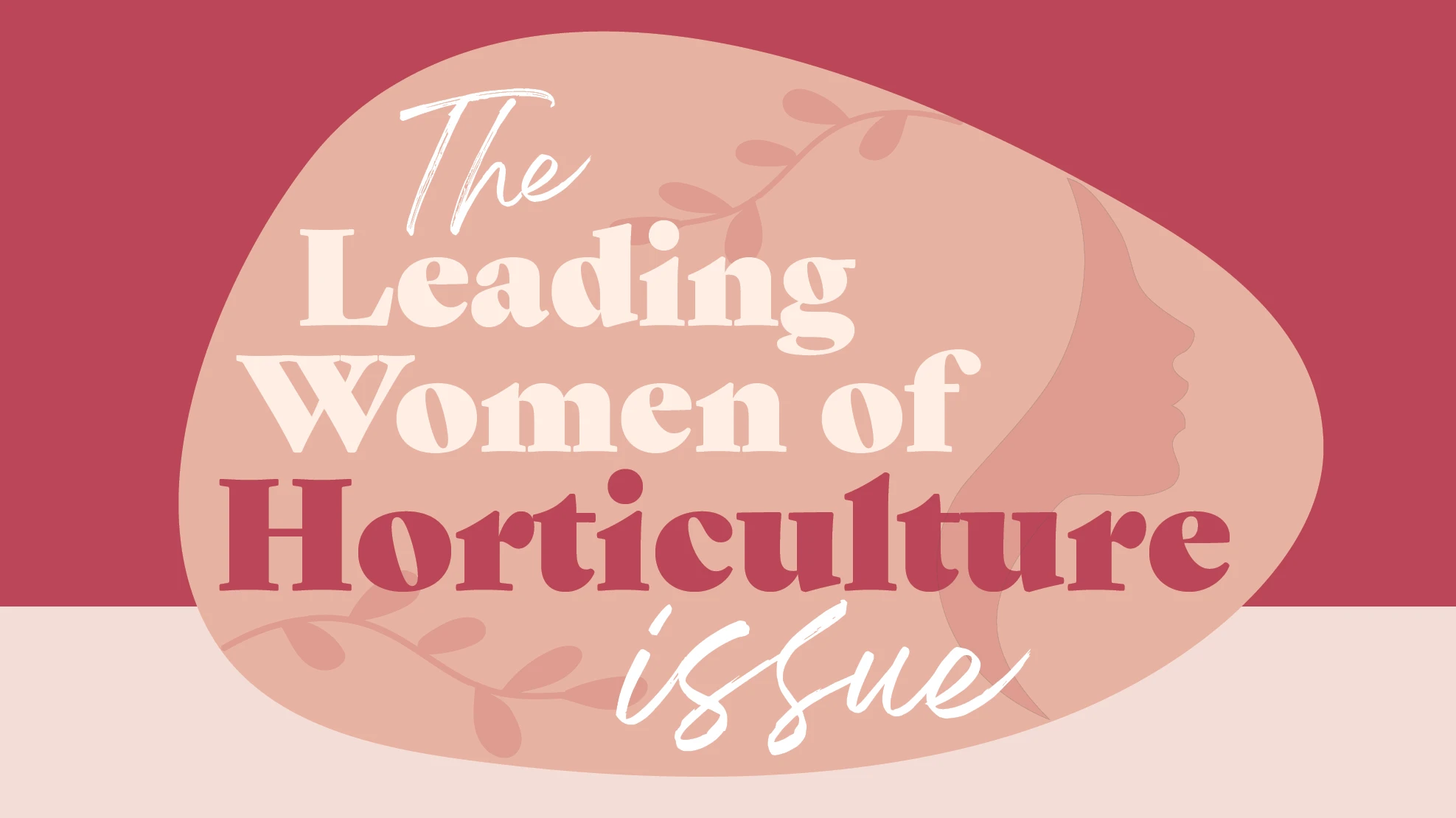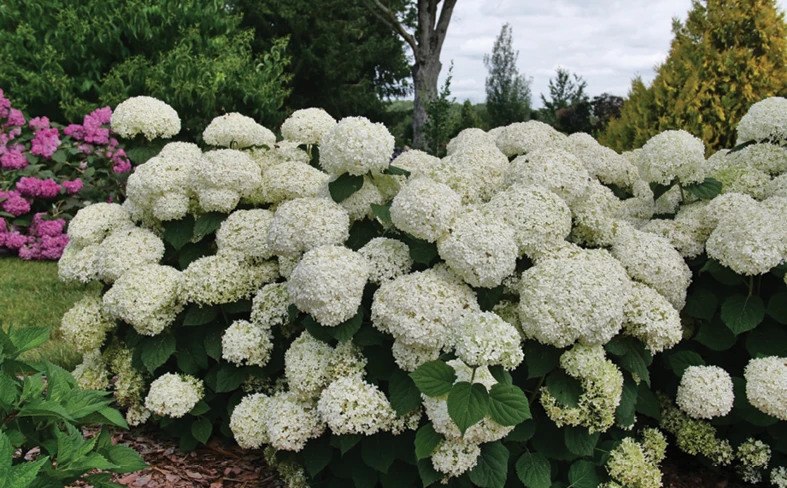
Hydrangeas, though exotic, have become a reliable thread in the fabric of southern society dating back to their introduction into North America in the 18th or 19th century. Many cultivars have been introduced recently stimulating a popular resurgence in the past 50 years. Two horticultural groups of H. macrophylla are recognized: “lacecaps” and “mopheads,” also called hortensias. Lacecaps have fewer sterile florets, but these showy parts circle round, flat flowerheads comprised of numerous, tiny flowers. The effect is striking in the landscape and can provide a more natural appearance. Mopheads have large, round corymbs consisting primarily of large, sterile flowers. Mopheads are in part popular because of their blue flowers (technically modified leaves called sepals), yet flower color can be manipulated to produce a range of colors from pink to lavender to blue depending on cultivar and soil chemical properties (Fig. 1a and b). It has been reported that some growers can sell on average 10 blue hydrangeas for one every pink, so controlling the color is crucial. First, however, the plants must be flowering at time of sale.

Production plans
Bigleaf hydrangea is considered hardy from USDA Hardiness Zones 6-9. However, hardiness varies among cultivars, and selection must be made carefully to match the location. Some cultivars are more cold hardy, but have less heat tolerance, and vice versa. Vernalization, a duration of cold temperatures for approximately 6 to 10 weeks, needs to occur to ensure a robust bloom either in the spring or prior to being forced to flower. Cold injury to the flower buds and improper pruning are the usual reasons for flower failure. Bigleaf hydrangeas form flower buds during late summer and early fall; therefore, flower buds are exposed to low winter temperatures and can be damaged by cold. Remontantcy is a major marketing factor for mophead hydrangeas because plants will flower in the spring and again during summer and fall. The first set of flowers in spring for remontant bloomers is also initiated the previous year, therefore all types of bigleaf hydrangea flowers can be damaged by cold. Pruning severely in late summer when floral buds are initiated or in winter decreases or eliminates flowers in spring. Prune plants for structure after the first flowers finish in late spring to promote remontantcy and avoid inhibiting flower production the following year.
High summer temperatures (≥86F) during the day are known to interfere with normal flower and vegetative development. Additionally, night temperatures (≥80F) are potentially damaging to previously formed flower initials; delaying, distorting, preventing new flower development, and/or causing vegetative distortion. The severe southeastern U.S. heat wave of June 2015 was believed to prevent some H. macrophylla selections from blooming while in production, thus resulting in a significant loss of sales. Root restriction in container production can also reduce flower initiation. Unfortunately, if plants do not sell because they have no flowers due to improper pruning, high temperatures, or cold damage, the situation worsens because roots become restricted if not potted into larger containers.

Manipulating flower color
Growing mophead hydrangeas with blue flowers is easy in southeastern U.S. landscapes because aluminum and other macronutrients are plentiful and soil pH is acidic (<7). Trying to replicate those conditions in containers, however, is not easy, because bark substrate pH is low, aluminum (Al) needs to be abundant, macronutrients, including calcium and magnesium, need not be limiting, and micronutrients need to be present to mitigate any unforeseen deficiencies, such as iron. Therefore, aluminum sulfate (AlSO4), ground or coarse dolomitic limestone, and micronutrients are incorporated in the substrate as amendments. Controlled release fertilizers are used to provide nitrogen, phosphorus, potassium and in some cases micronutrients. Your dolomite amendment should result in maintaining a substrate pH of 4.5 to 5.5 throughout production. In general, the sepal color intensity is determined by a cultivar’s inherent ability to produce blue pigment, the amount and availability of aluminum in the substrate managed by aluminum addition and pH, and a cultivar’s ability to accumulate aluminum from the substrate. When the substrate pH is acidic (4.5 to 5.5) and aluminum is present, sepal color can be expected to be blue because aluminum is generally highly available at a low pH. At pH = 6.0, aluminum is less available in the substrate regardless of the amount; therefore, sepal color is most likely pink. Between pH 5.5 to 6.0, sepal color might be pink, blue, or lavender, or a mixture of pink and blue flowers may be present on the same plant. This is highly dependent upon cultivar. The flower color is not permanent.
Incorporation of AlSO4 at a rate of 12.5 pounds per cubic yard of substrate is required because soilless substrates like pine bark have little or no aluminum. The aluminum in AlSO4 simultaneously lowers the pH, making aluminum more available, and increases the amount available for uptake by the plant. If the substrate pH is >5.5, or aluminum was absent during potting, topdress with polymer-coated AlSO4 at the labeled rate or drench a moist container at a rate of approximately 1.5 fluid ounces (45 grams) per gallon (10 pounds AlSO4 per 100 gallons of water) before flower buds form to increase bluing. Ideally, aluminum will be in containers from potting to sale. Drenches should be repeated every 10 to 14 days and should not coincide with fertigating with a complete fertilizer containing phosphorus (P). Phosphorus can bind to aluminum, making it less available. Guides for greenhouse production of hydrangea recommend fertigating with moderate nitrogen (N) rates, no or low P, and high potassium (K) rates; therefore, using an incomplete fertilizer (no P) or one with low P with a ratio of 6N: 1 P2O5: =6K2O is preferred when forcing hydrangeas or targeting blue flowers. This has resulted in controlled release fertilizer with less phosphorus; however, one must be cautious when limiting phosphorus since it can become limiting and decrease overall growth, leaf size or result in purpling of leaves. Additionally, if acidifying irrigation water, use sulfuric acid or nitric acid instead of phosphoric acid to minimize the interaction of phosphorus and aluminum to maximize aluminum availability.
Substrate differences
Variables that affect aluminum availability include substrate components, substrate amendments including lime and phosphorus, time of potting, irrigation water quality, the volume of rainfall and irrigation plants received, and the formulation, application method and rate of fertilizer. Testing the water supply is crucial to gain the necessary information on water pH and alkalinity. Aluminum toxicity can damage or kill roots, stunt plants and flowers, cause leaves to drop and the smaller flowers to abort (Fig. 2). Not only can aluminum toxicity damage crops, but so can low pH. Plant death can also occur; therefore, use of AlSO4 must be done carefully and on a small scale until the grower becomes familiar with how the plants will respond in their individual production system.
Adding specific fired clays or industrial mineral aggregates may provide a method to increase aluminum availability without having to manage dangerously low pH levels or aluminum toxicity in containers. The addition of 10 percent Kaolite (v/v), a calcined clay mineral, in the potting substrate increased aluminum availability and sepal blueness. Kansas State University determined plants grown in 10-20 percent zeolite (another clay mined from volcanic rocks and ash layers reacted with alkaline groundwater), precharged with Al, produced blue sepals, but growth was reduced when zeolite levels reached 30-40 percent in substrates. While at Oregon State University, Jim Owen determined that increasing levels of Pozzolan (amorphous aluminosilicate) increased blue sepal color and consumer desirability ratings, both of which were best when AlSO4 and Pozzolan were used in combination. When using Pozzolan, adding calcined clay and AlSO4 supported blue sepals even at higher pH.
Mineral soils normally have sufficient levels of aluminum. Therefore, elemental sulfur rather than AlSO4 is recommended. Sulfur alone lowers the pH to 4.5-5.5, so that the naturally occurring aluminum is available to plants and additional Al does not need to be added, avoiding potential toxicity. Field-grown mophead hydrangeas can be induced to bloom blue by lowering the soil pH several months in advance of bud set (six months if pH is high). However, lowering the pH rapidly with a large amount of sulfur can cause the soil pH to go below 4.0, which can damage or kill roots. Before planting any crop or adjusting pH, test the soil.

Blues and beyond
Hydrangeas that have blue flowers readily in the landscape or field are often thought of as easy to grow in container production. This is true when substrate, irrigation, and aluminum are managed closely. Be prepared to experiment with these factors to maintain a pH in containers between 4.5-5.5; provide available aluminum without causing toxicity; amend with calcium and magnesium; and irrigate with enough water to prevent desiccation injury, but not leach nutrients necessary to produce plentiful, verdant canopies laden with vibrant, blue flowers.
A few cultivars do not turn blue regardless of soil pH, or have several colors on an individual inflorescence. Check with your liner supplier to confirm range of flower color. Additionally, some newly bred mophead hydrangeas such as BloomStruck do not turn completely blue regardless of cultural or production practices, resulting in florets with blue-purple or “blurple” coloring (Fig. 3).

Explore the September 2017 Issue
Check out more from this issue and find your next story to read.





